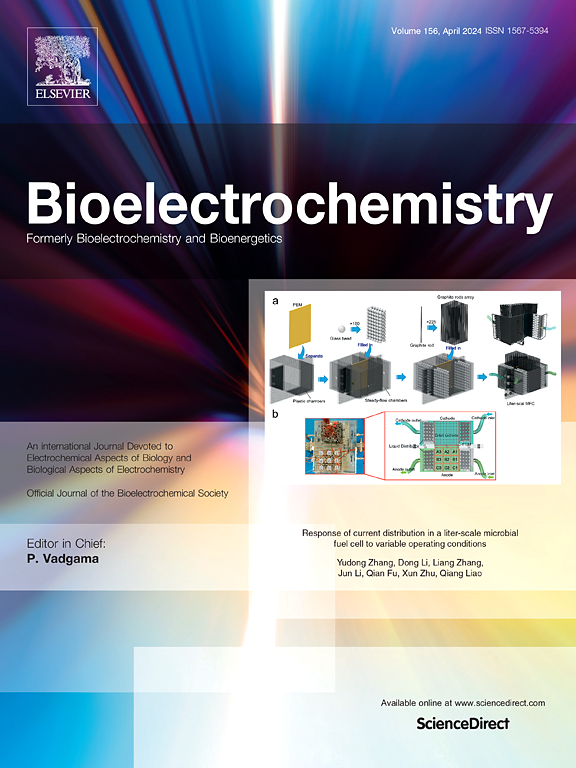小牛胸腺DNA与皮肤增白剂熊果苷相互作用的电化学和计算研究。
IF 4.8
2区 化学
Q1 BIOCHEMISTRY & MOLECULAR BIOLOGY
引用次数: 0
摘要
本文首次应用电化学和计算方法研究了小牛胸腺双链DNA (ctDNA)与皮肤增白剂熊果苷(AR)的相互作用。采用循环伏安法(CV)和差分脉冲伏安法(DPV)测定了一次使用铅笔石墨电极在不含ctDNA和存在ctDNA情况下的动力学和热力学参数。为了研究相互作用过程,在加入不同浓度的ctDNA之前,观察了AR的氧化峰电流和电位。在298 K时,AR-DNA配合物的结合常数(KAR-DNA)和Gibbs自由能(ΔG°)分别为1.82 × 104L/mol和-24.30 kJ/mol。采用范霍夫方程,利用热力学参数(ΔH°:-30.30 kJ/mol和ΔS°:-0.00197 kJ/mol)对相互作用进行温度评价。考虑到潜在的氢结合中心,应用福井函数和二阶微扰理论确定了分子结构中的局部相互作用位点。将优化后的AR结构与显示AR-DNA复合物结合位置的DNA结构结合。实验和计算结果表明,AR-DNA通过常规氢键、疏水相互作用和范德华力通过小槽模式与ctDNA结合。本文章由计算机程序翻译,如有差异,请以英文原文为准。

Electrochemical and computational studies on the interaction between calf-thymus DNA and skin whitening agent arbutin
The interaction between double-stranded calf thymus DNA (ctDNA) and the skin whitening agent arbutin (AR) examined by applying electrochemical and computational methods for the first time in literature. A single-use pencil graphite electrode via cyclic (CV) and differential pulse voltammetry (DPV) techniques were applied to determine the kinetic and thermodynamic parameters in the absence and presence of ctDNA. To examine the interaction process, oxidation peak currents and potentials of AR were observed prior to the addition of various ctDNA concentrations. The binding constants (KAR-DNA) and Gibbs free energy (ΔG°) values for the AR-DNA complex were determined as 1.82 × 104 L/mol and −24.30 kJ/mol at 298 K, respectively. Temperature evaluation of the interaction was examined using thermodynamic parameters (ΔH°: −30.30 kJ/mol and ΔS°: −0.00197 kJ/mol) applying the Van’t Hoff equation. The local interaction sites in the molecule structure were determined by applying Fukui functions and second-order perturbation theory in view of potential hydrogen binding centers. The optimized structure of AR was applied with a DNA structure revealing the binding position for AR-DNA complex. Experimental and computational examinations suggested that AR-DNA binds to ctDNA through a minor groove mode via conventional hydrogen bonds, hydrophobic interactions and van der Waals forces.
求助全文
通过发布文献求助,成功后即可免费获取论文全文。
去求助
来源期刊

Bioelectrochemistry
生物-电化学
CiteScore
9.10
自引率
6.00%
发文量
238
审稿时长
38 days
期刊介绍:
An International Journal Devoted to Electrochemical Aspects of Biology and Biological Aspects of Electrochemistry
Bioelectrochemistry is an international journal devoted to electrochemical principles in biology and biological aspects of electrochemistry. It publishes experimental and theoretical papers dealing with the electrochemical aspects of:
• Electrified interfaces (electric double layers, adsorption, electron transfer, protein electrochemistry, basic principles of biosensors, biosensor interfaces and bio-nanosensor design and construction.
• Electric and magnetic field effects (field-dependent processes, field interactions with molecules, intramolecular field effects, sensory systems for electric and magnetic fields, molecular and cellular mechanisms)
• Bioenergetics and signal transduction (energy conversion, photosynthetic and visual membranes)
• Biomembranes and model membranes (thermodynamics and mechanics, membrane transport, electroporation, fusion and insertion)
• Electrochemical applications in medicine and biotechnology (drug delivery and gene transfer to cells and tissues, iontophoresis, skin electroporation, injury and repair).
• Organization and use of arrays in-vitro and in-vivo, including as part of feedback control.
• Electrochemical interrogation of biofilms as generated by microorganisms and tissue reaction associated with medical implants.
 求助内容:
求助内容: 应助结果提醒方式:
应助结果提醒方式:


